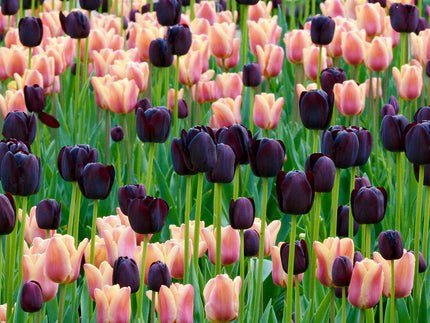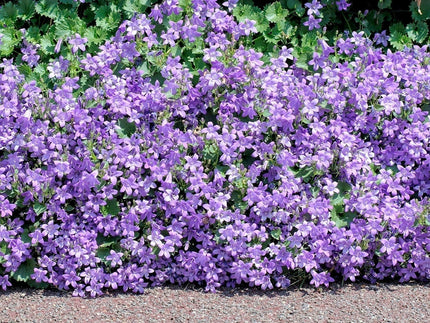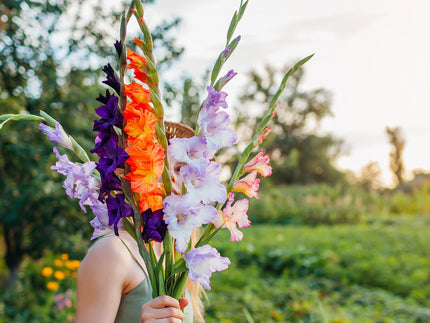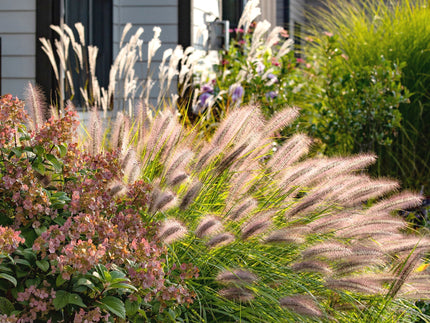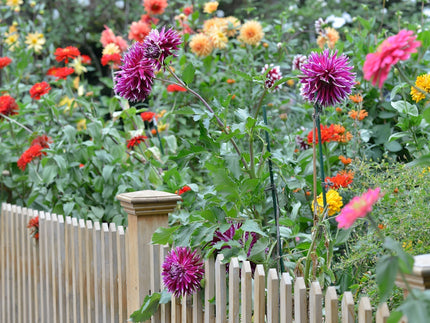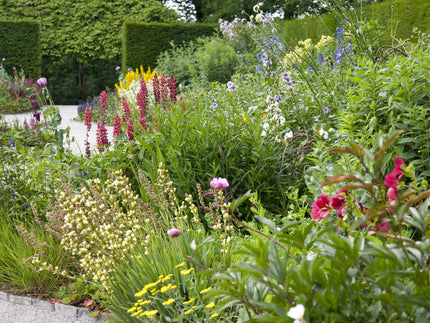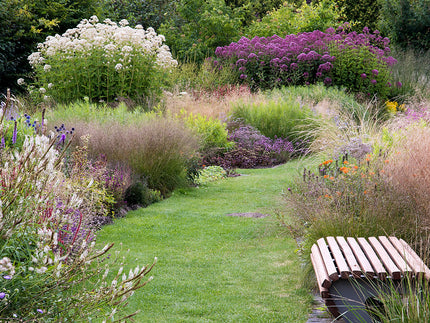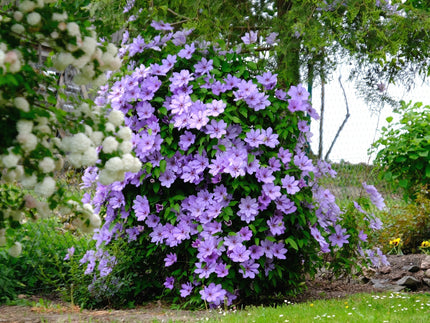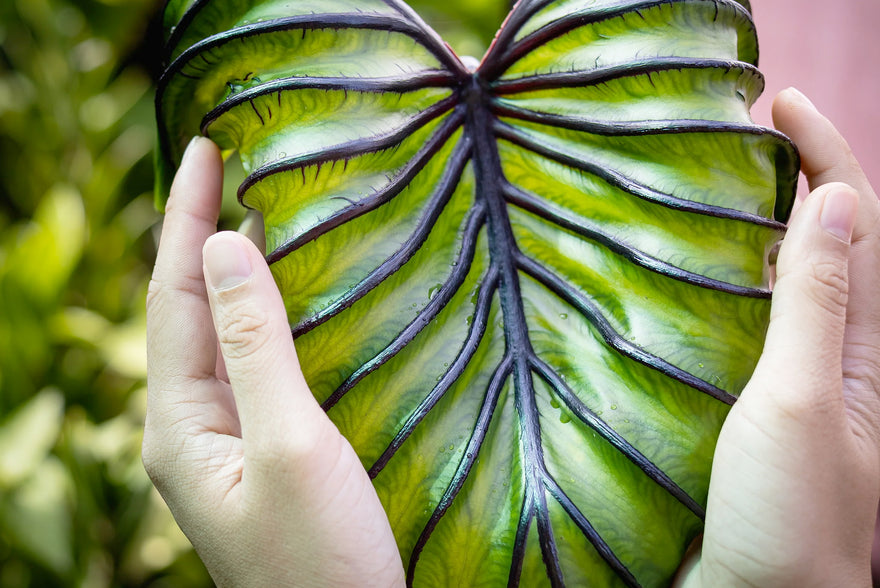
Growing tropical bulbs — all you need to know
With a bit of bright, indoor growing space and a selection of top-notch tropical bulbs, it’s easier than you might think to create your own mini version of an exotic paradise. Even in cool climates, you’ll find it’s possible to enjoy plants which would normally be found in steamy jungles or holiday islands, without even needing your passport! Whether you choose to stick to an indoor jungle or set them outside for summer, you can surround yourself with a splash of lush leaves and sizzling blooms.
Creating an outdoor tropical planting scheme
Tropical planting schemes are characteristically full of soothing verdant foliage, and there are also many which brandish colourful leaves or flowers. Flowering tropical plants deliver sizzling colours and unusual flower forms that stand out against the leafy backdrop. You can enjoy a tropical planting scheme indoors or out, but it is essential to remember when growing tropical plants outdoors that they don’t like to get cold, so they can only go outside during the summer months in cool climates. When outside, they are best in a sheltered or secluded garden where wind can’t damage their leaves.

Tropical plants like Caladium, Colocasia and Gloriosa can be incorporated into a summer planting scheme once the weather is reliably warm. To get them started, in spring the bulbs should be planted into pots and positioned in a warm, bright spot indoors.
Take a look at our full range of tropical bulbs and plant and discover a blast of splashy colours you can enjoy in your garden. You may need to work your green-fingered magic a little harder with tropical bulbs because they do require a bit more care and understanding than plants which are better adapted to our climate, so if you want a full-to the-brim jungle garden we recommend padding out your planting scheme with some lower maintenance, non-tropical varieties and then incorporating in any special tropical treasures that you can manage. Non-tropical varieties which have a long flowering time, exotic feel and combine well with tropical plants include coral-coloured cactus dahlias (which also have plenty of lush foliage), lilies, callas, cannas and even bright begonias which can really pop in the shadier understorey.
After summer, you’ll need to protect your tropical plants from cold autumn and winter temperatures. Perennial bulbs will naturally die back in autumn so the bulbs can be lifted from the soil and stored in dry, airy conditions over winter. Average room temperature or slightly lower is usually fine for storing tropical bulbs while they are dormant. Frost-free conditions, such as an unheated greenhouse or shed may be a little too cold for some tropical varieties which can result in unsuccessful storage. If your tropical bulbs remain in pots, you can bring the pot indoors in autumn and keep the soil dry over winter while they’re resting. Alocasia can remain evergreen indoors.
How to create an indoor jungle
Many tropical bulbs can be grown indoors and bring some seasonal colour to your indoor garden. If you’re keeping plants indoors, it’s essential that you give them a space which receives a lot of natural daylight, although try to avoid positioning plants right up against a sunny window, because strong sunlight can scorch the leaves. Slightly further back, the sunlight will be more filtered and less damaging.
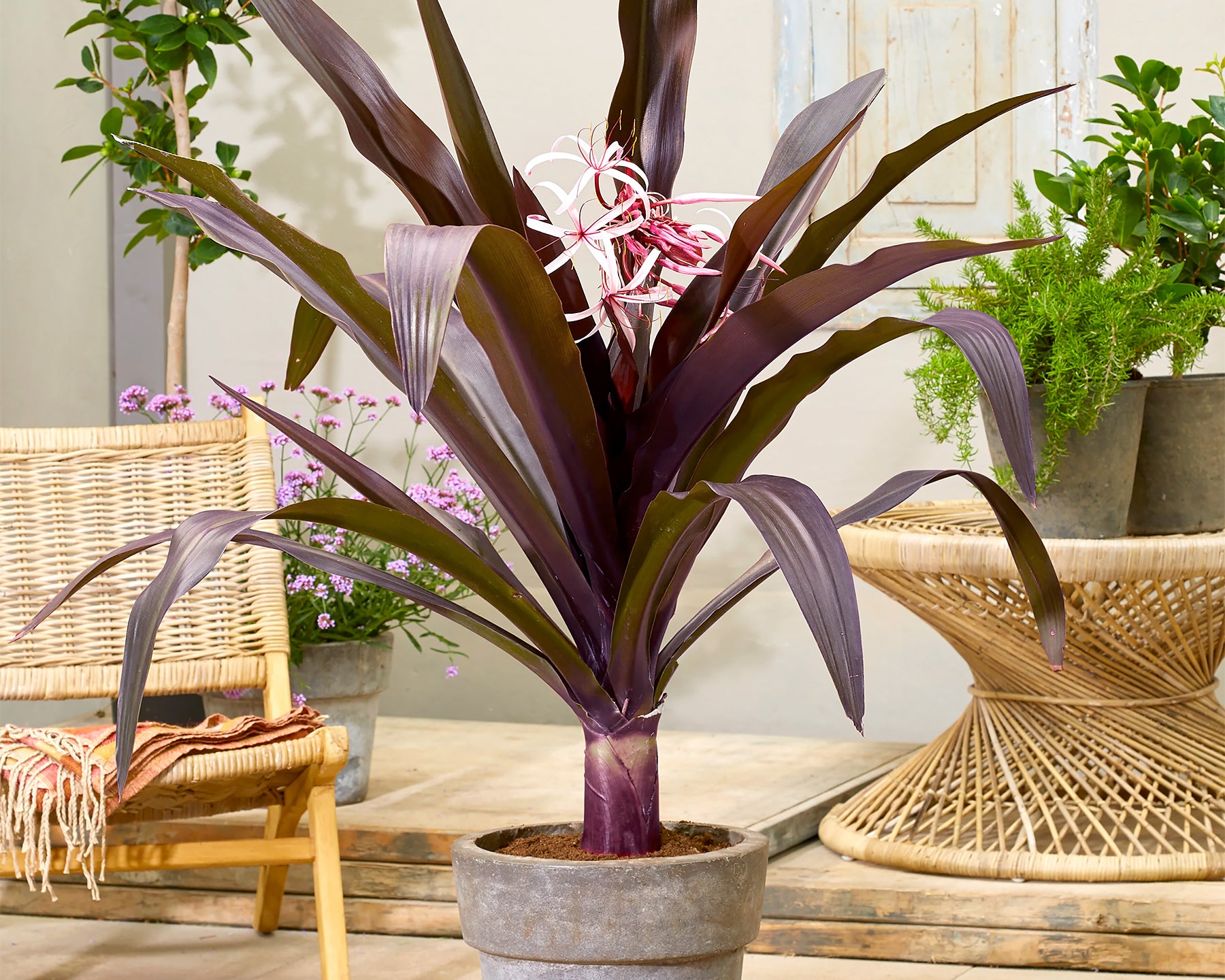
You should consider plant shelving, racks or indoor hanging containers to create that much-desired, floor to ceiling wall of plants. If you have enough space, position houseplants across two walls or a corner, or even three walls in a smaller room, to create a lush dense cosy plant-packed surround for a seating area or work space. If you happen to have a conservatory which is heated during winter, this is perfect for exotic plants and you can really go to town with the tropical planting, building your collection over the years to turn it into an indoor exotic garden.
Plants with height and large leaves, like Colocasia and Alocasia are a great place to start, because one bulb will produce a relatively large and leafy plant which can give you that jungle vibe fairly quickly. Bulbs like Caladium are smaller but colourful, rewarding to grow and quite good fun to collect. Crinum asiaticum grows from an impressively large bulb, producing large purple strap-shaped leaves which contrasts with neighbouring greenery. Add to your indoor jungle some fascinating flowering plants like Scadoxus, Lycoris or Plumeria and you can enjoy extra excitement through the season.
Top tropical bulbs to grow
There’s no shortage of species that will give your garden an exotic feel. Cannas and Hedychium (ginger lilies) are popular for their captivating blooms and imposing stature in sunny borders. Once established, they can be fairly resilient and can simply be lifted and stored in an unheated greenhouse each winter or shed over winter, just like dahlias.
You’ll also need some jazzy foliage, so opt for shade-loving caladiums which come in a myriad of patterns and colours. They’re fairly low growing, which makes them ideal for underplanting in a sheltered space. Mingle them with Colocasia and Alocasia with their huge heart-shaped leaves, and you already have the beginnings of a secluded leafy hideaway.

Something a little different to show off to your guests is Amorphophallus bulbifer. It’s usually only seen in botanical glasshouses, but this jungle native can flourish outdoors in a very sheltered spot, even tolerating light frost. Especially for a conservatory or a bright windowsill, Plumeria is a compact tree (which can be pruned to stay small)—it’s a striking houseplant which throws out flowers with an exquisite fragrance.
For more inspiration, explore our full range of tropical bulbs and plants!
How to grow tropical bulbs
When your tropical bulbs arrive, open the packaging to check that they are in perfect condition, you may also need to take a moment to absorb how unfamiliar they look. Colocasia esculenta and Crinum asiaticum 'Purpureum' are impressive bulbs which deserve some pre-planting admiration! You should get all tropical bulbs potted as soon as possible while they’re fresh.
If you can’t plant them straight away, you can usually store them for a few weeks in a cool, dry place indoors. Avoid storing tropical bulbs in a cold place even if it is frost free, because these species aren’t adapted for cold temperatures and can quickly deteriorate.
Planting tropical bulbs
Before you begin, please take a look at our helpful growing guides to learn exactly how each species likes to be grown. They all have specific requirements, so to avoid a disappointing experience you should take time to find out their preferences.
Getting the temperature right for tropical bulbs
Most tropical bulbs are planted in the spring, but the temperatures outside during spring will not be warm enough for these delicate plants, even if there is no risk of frost. Very tender species such as caladiums and colocasias need constant temperatures of around 20°C to break their dormancy. These should be potted-up and positioned in a warm, bright spot indoors. Once the bulbs have sprouted and the weather is consistently warm, they can be moved outside. Plumerias are also very tender and ideally should be indoors all year round. You can position them outside in the height of summer—during which time they require temperatures of above 20°C. In winter they should be kept in conditions no cooler than around 15°C.

Slightly hardier tropical species, such as Gloriosa, Canna, Calla, Sauromatum, Eucomis, Hedychium, and Cardiocrinum, can be started in a greenhouse or cool conservatory in temperatures now lower than around 10°C. Once they are all growing well and risk of frost has passed (usually by around mid May) they can be moved outdoors or transplanted into their final positions. These varieties can also be planted directly outside in May, although it is better to give them the head-start indoors first if you can.
Choosing pots for tropical bulbs
Growing tropical bulbs inevitably means that your window areas and greenhouse benches will be lined with pots of newly sprouting bulbs and tubers in spring. You’ll need to maximise the space you have so always choose pots that are the just big enough to comfortably contain your bulb or tuber.

Over-potting wastes space, but also risks the plant rotting before it has a chance to grow. Where there is a greater volume of soil, this will also hold an increased volume of water which can be detrimental to dormant bulbs. For the same reason, its equally important that the pots have sufficient drainage holes to ensure that any excess water is able to escape after each watering. Plants growing in pots can be potted up when required, so if you notice that the pot is filling with roots, you can move it into a pot the next size up.
What soil to use for tropical bulbs
Tropical bulbs generally enjoy a rich and fertile, well-drained soil, although some demand speedier drainage so it’s worth checking their preference before you start. Always use a fresh bag of good quality, multipurpose compost unless a more specific growing mix is advised in our growing guides.
Once they have outgrown their first pots, they can be potted up into larger pots. Multipurpose generally works well for a full growing season, or for some varieties you can choose a loam-based compost such as John Innes number 2, which has a little more body.

If you are planting tropical bulbs like cannas directly into borders after risk of frost has passed, it’s essential to make sure the soil is well dug and free draining. Some garden soils can be heavy and hold too much moisture which can rot a tender bulb in cool climates. Before planting, improve the soil by digging in plenty of compost or well-rotted organic matter. This will help to feed the soil and improve drainage which encourages good establishment.
Planting depth for tropical bulbs
Tropical bulbs have specific requirements so it pays to read our online growing guides for each variety before to check specific planting depths when they arrive. Checking the correct planting depth is particularly important. Unlike many hardy bulbs, some tropical varieties prefer quite shallow planting, such as calla lilies, caladiums and colocasias. In a cool climate, deeper planting means that they are not only cooler, but also wetter, and this can cause them to rot.
Light levels for tropical plants
Light is an important variable for the growth of tropical plants. In their natural habitats, some will enjoy basking in bright sunshine, while others prefer dappled shade/filtered light. Mimicking their natural habitat will produce the best displays and prevent spindly growth or scorched leaves.

If growing indoors, a north or east-facing window usually ideal for shade loving species indoors. However, they do benefit from the extra warmth of a sunny window while they are still dormant or just starting to sprout.
If position them outside, follow each plant’s preferences on sunlight levels. cannas, for example, like to be in full sun, whereas caladiums thrive in shade or partial shade.
When to water tropical bulbs
Tropical bulbs can take many weeks to come out of dormancy, and during this time they are vulnerable to rotting if the soil remains consistently wet. Many of the larger-leaved tropical species have an insatiable thirst in summer when they are in full growth, but while they are dormant they require very little water.
Aim to keep the soil slightly damp but never soaking wet—water tropical bulbs well after planting, but allow any excess water to drain thoroughly from the pot. You won’t need to water them again until you see that compost is starting to dry out, and then only apply sufficient water to make it damp again.
Once your plants start to grow, you will notice that the compost dries out more frequently because the roots are using the available water as they grow. However, the same principles apply—aim to maintain a damp soil and always allow the pot to drain afterwards.
Feeding tropical bulbs
Bulbs act like a food store for the plant, which means that they don’t require additional feeding to perform well. However, they will benefit from additional feeding during the growing season. Like all plants, tropical species require nutrients to grow and mostly this is provided by good quality compost. After a while, potted plants can become deficient of nutrients if no further nutrients are added to their growing environment, so a fortnightly liquid all-purpose feed can be applied.
Dormancy and overwintering tropical plants
As summer ends, tropical plants will notice the drop in temperatures and may start to droop or fade. When their growth starts to slow down, they will need less water and no more feed. The leaves of perennial tropical bulbs will naturally begin to die back. Tropical plants (depending on species) should either be moved indoors or stored away in frost-free conditions before frost occurs.

More resilient species like cannas, ginger lilies and dahlias can either be moved in their pots to a greenhouse for winter or lifted and stored in cool, dry, frost-free conditions. Caladiums and colocasias must be stored in a warmer environment than a shed or greenhouse, such as in a cool part of your home. They can be kept in their pots with dry soil over winter, or lifted and stored in crates with a light covering of loose, dry compost.
It’s worth checking stored tubers from time to time. Remove and dispose of any which are turning soft or mushy to prevent them affecting the rest of your stored plants. Once the warmer spring weather returns from March onwards you can take them out of storage and repot them to begin their growth cycle again.





















































































